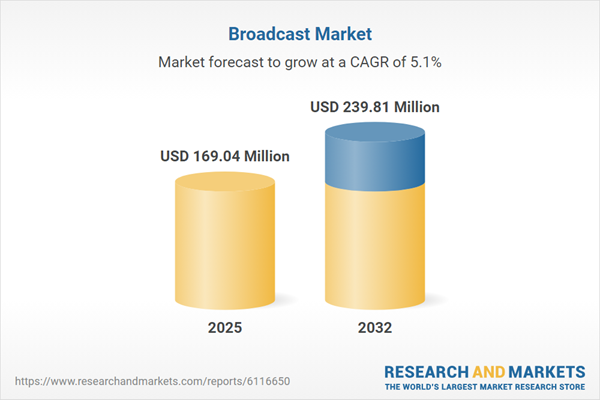Speak directly to the analyst to clarify any post sales queries you may have.
The broadcast market is experiencing accelerated transformation, shaped by technological advances and evolving audience preferences. As senior decision-makers adapt strategies, understanding the interplay between traditional platforms and digital streaming services is essential to capitalize on opportunities and address disruption across the dynamic audio-visual landscape.
Market Snapshot
The Broadcast Market grew from USD 161.20 million in 2024 to USD 169.04 million in 2025. It is forecast to sustain momentum at a CAGR of 5.09%, reaching USD 239.81 million by 2032.
Scope & Segmentation
This report examines the global broadcast market, analyzing how technological changes, content formats, and evolving end-user needs are reshaping the competitive context.
- Platform Type: Mobile, Over-the-top (OTT), AM/FM Radio, Digital Audio Broadcasting (DAB), Hybrid Digital Radio, Digital Radio, Television
- Content Type: Movies, Reality, Scripted, Classical and Pop Music, News, Sports Highlights, Live Sports
- Broadcast Schedule: Live Broadcasting, On-Demand Content, Pre-recorded and Scheduled Programming
- End User: Commercial advertisers, Media agencies, Retailers and brands, Educational institutions, Event and sports organizers, Individuals
- Geography: North America (United States, Canada, Mexico), Latin America (Brazil, Argentina, Chile, Colombia, Peru), Europe, Middle East and Africa (United Kingdom, Germany, France, Russia, Italy, Spain, Netherlands, Sweden, Poland, Switzerland, UAE, Saudi Arabia, Qatar, Turkey, Israel, South Africa, Nigeria, Egypt, Kenya), Asia-Pacific (China, India, Japan, Australia, South Korea, Indonesia, Thailand, Malaysia, Singapore, Taiwan)
- Representative Companies: Comcast Corporation, The Walt Disney Company, Amazon Web Services, Inc., Belden Inc., Blackmagic Design Pty. Ltd., Charter Communications, Inc., Cisco Systems Inc., CommScope, Inc., Fox Corporation, Fuji Media Holdings, Inc., Gray Television, Inc., Harmonic Inc., IBM, ITV plc, Nexstar Media Group, Nippon Television Holdings, Panasonic Corporation, Paramount Global, RTL Group SA, Sinclair Broadcast Group, Sirius XM Holdings, Sony Corporation, TBS Holdings, The E.W. Scripps Company, Warner Bros. Discovery, Inc.
Key Takeaways
- Convergence between linear broadcasting and on-demand streaming is accelerating, requiring hybrid distribution models to meet shifting consumer expectations and institutional demands.
- Digital radio formats like DAB and HD radio are enhancing audio quality, while the adoption of 8K and Ultra HD delivers advanced visual experiences across target segments.
- Regional market growth reflects diverse drivers, from mobile-first content consumption in Asia-Pacific to the emphasis on localized programming in EMEA and evolving monetization models in the Americas.
- Industry consolidation, strategic partnerships, and direct-to-consumer models are driving new competitive advantages, with ecosystem integration supporting differentiated offerings and operational efficiencies.
- Content production and licensing workflows are adapting as live sports, real-time news, and scripted entertainment integrate interactive features and personalized engagement tools.
Tariff Impact
The introduction of new United States tariff measures in 2025 has elevated equipment costs and disrupted supply chain stability for content delivery and transmission infrastructure. Broadcasters are reevaluating vendor relationships, considering onshore production, and pursuing collaborative partnerships to reduce expenses and uphold pricing competitiveness. These actions are reshaping strategies for investments in broadcast equipment, content procurement, and long-term technology upgrades.
Methodology & Data Sources
This research integrates primary interviews with executives across broadcasting, technology, and content sectors, supported by secondary analysis of industry publications, regulatory filings, and annual reports. Quantitative techniques and data triangulation underpin segment analysis, ensuring accuracy and reliability in the depiction of market trends.
Why This Report Matters
- Equips decision-makers with actionable insights for navigating market complexities, technological innovation, and regulatory changes within the broadcast sector.
- Supports the development of strategies tailored to diverse platforms, segments, and regions for sustained growth and market resilience.
- Enables effective allocation of investment by highlighting shifts in consumer behavior, tariff impacts, and competitive dynamics.
Conclusion
Staying ahead in the broadcast market requires informed adaptations to evolving technologies, shifting consumer patterns, and regulatory influences. Organizations can leverage these findings to strengthen decision-making and position themselves for sustainable growth across the global audio-visual ecosystem.
Table of Contents
3. Executive Summary
4. Market Overview
7. Cumulative Impact of Artificial Intelligence 2025
Companies Mentioned
The companies profiled in this Broadcast market report include:- Comcast Corporation
- The Walt Disney Company
- Amazon Web Services, Inc.
- Belden Inc.
- Blackmagic Design Pty. Ltd.
- Charter Communications, Inc.
- Cisco Systems Inc.
- CommScope, Inc.
- Fox Corporation
- Fuji Media Holdings, Inc.
- Gray Television, Inc.
- Harmonic Inc.
- International Business Machines Corporation
- ITV PLC
- Nexstar Media Group, Inc.
- Nippon Television Holdings, Inc.
- Panasonic Corporation
- Paramount Global
- RTL Group SA
- Sinclair Broadcast Group, Inc.
- Sirius XM Holdings Inc.
- Sony Corporation
- TBS Holdings, Inc.
- The E.W. Scripps Company
- Warner Bros. Discovery, Inc.
Table Information
| Report Attribute | Details |
|---|---|
| No. of Pages | 180 |
| Published | November 2025 |
| Forecast Period | 2025 - 2032 |
| Estimated Market Value ( USD | $ 169.04 Million |
| Forecasted Market Value ( USD | $ 239.81 Million |
| Compound Annual Growth Rate | 5.0% |
| Regions Covered | Global |
| No. of Companies Mentioned | 26 |









